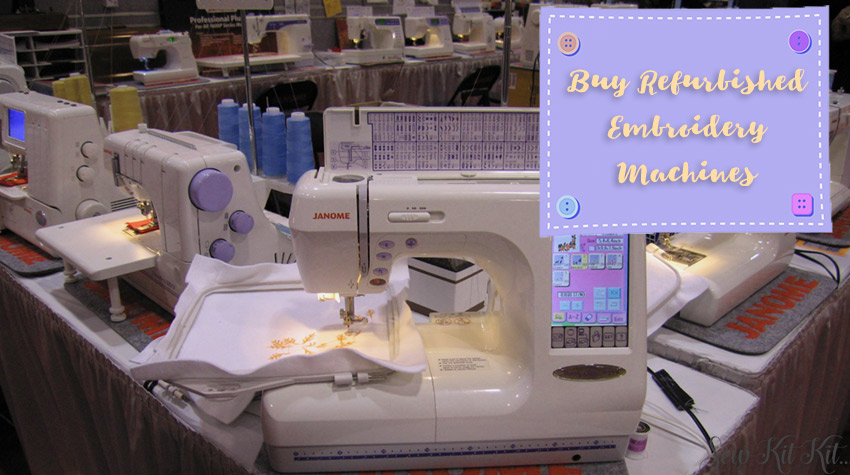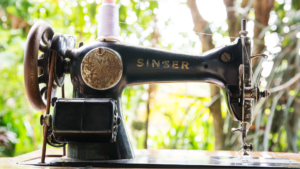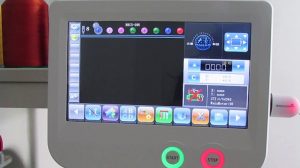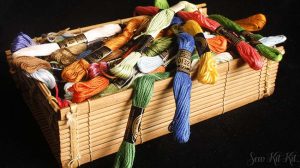Last Updated on January 10, 2023
Nothing beats the feeling of getting something brand new, fresh out of the factory. When it comes to purchasing embroidery equipment, brand new machines are going to produce great-looking embroidery for you right off the bat, with almost no headaches.
New machines are going a lot of the cutting edge features that amaze visitors at industry trade shows. The obvious downside to them, however, is going to be the price. There’s no way around it; new machines are expensive. Because of this, purchasing a used or reconditioned machine offers substantial savings compared to getting one right off the line.

Table of Contents
Guide to Buy Refurbished Embroidery Machines
The current economy has created an overabundance of used equipment definitely making it a buyers market. People can sometimes be hesitant about buying what they perceive as older technology. It’s natural to want something new, but you have to be realistic. Getting a $20,000 machine for under $10,000 can make the decision pretty logical from a financial standpoint.
There are two main avenues you can pursue in purchasing used machinery. The first is buying from an owner directly. The second is going through or through an independent reseller specializing in reconditioned machines (or from the manufacturer itself).
More Than Just a Lower Price
People just entering the industry mistakenly believe there is nothing to operating a machine, but it doesn’t take long to realize there’s a lot to learn. You have to have training. Unfortunately, if you buy a used machine you may not get what you need.
All potential buyers need to take serious consideration into the type of work they are planning to use the machine for. A hobbyist just taking the leap into commercial embroidery and an existing professional looking to expand production will have many different requirements in the features and capacity abilities of the machines each chooses. It can be a tricky decision – you do not want to purchase more than you actually need, while still keeping in mind for future growth.
Another major consideration is the warranty. A used machine typically comes with no warranty if purchased from an individual or a limited, short-term one if purchased from a third party.
The industry standard is 90 days, parts, and labor, compared to a one-year warranty on a new machine. As with training, most companies offer to build warranty costs into the final price of the used machine.
It is impossible to overemphasize how important getting a warranty is for someone buying used, especially for someone just starting out. When you put up a large chunk of money for a machine, can’t afford problems with it.
For new embroiderers, just one problem can shut the business down. This is not as big of an issue for veteran embroiderers since they will likely have at least one other machine to bridge the gap in an emergency.
Buying Directly from an Owner
In terms of price, you will almost always receive the best deal if you buy directly from an individual or company selling their own machine. In these sorts of transactions, however, the buyer is responsible for delivery and installation, and no warranty will be offered. Training will be at the discretion of the seller. Buying on the open market should be reserved only for experienced embroiderers unless a newcomer has a mentor to help with the process.
You are essentially taking someone’s word when buying this way. Usually, you’ll find these machines in online classifieds or word of mouth. The seller is rarely someone you know, so you are going to have to become a private investigator before putting your money down.
If possible, call service representatives who have worked on that machine in the past. The seller should be willing to give you that type of information. The technicians will be able to tell you about the unit’s service record.
It’s just like buying a used car. You aren’t going to put any money down until a mechanic gives it his blessing. If you talk to someone who has worked on the machine or can have a tech actually go over it for you, it will give you a realistic picture of the investment you are making in terms of what to expect.
A seller who advertises a machine as being in “great shape” might be telling the whole truth as they know it, it is what they don’t know about their machines that might cause trouble.
In reality, most people have no idea what the actual condition of their machine is. You can walk up to a machine that is in production and see it running fine, never realizing that the trimmer system is almost worn out.
Saying that a machine is in perfect working order may be true, but no one will really know for sure until it is actually opened up and inspected by a professional.
Buying from a Third Party
A reconditioned machine is going to cost more than a used machine due to the parts and labor required to bring it up to peak operating conditions. Both independent machine resellers and manufacturers take ownership of machines and tear them down, clean or replace all the components, then reassemble them. While they may not be “good as new” reconditioned machines from a reseller come very close.
With the larger price tag, a reconditioned machine brings the option of having a warranty or training included. Delivery and installation can all be handled as well. This additional peace of mind is invaluable for embroiderers with limited industry experience.
What to Look for
When shopping for a used machine, there are several factors to keep in mind. First, you should have a realistic idea of the size and type of machine you will need, based on the order mix your business brings in. Online classified ads will be the best place to start, but a call to machine technicians can tip you to equipment available that hasn’t been listed for sale yet.
When you narrow the possible sources down to one or two individuals or companies, make sure to look at the machine to see if there are visible problems or missing parts, and how the machine runs. Then ask about the age, features, capabilities, and service record before any reconditioning. Also, ask whether reconditioning has been done, and what the original operational environment was like.
Find out if the previous owner had a high-volume shop running nonstop or if it was a small enterprise that never kept the machine busy enough to pay for itself.
Focus on a few key machine parts which may reflect the unit’s condition and maintenance record. The driver box is a good starting point for your inspection. If it is full of dust or you can barely see the driver boards for the lint, then that is a tip to the overall condition of the machine.
You can camouflage a lot of problems when you are trying to sell your machine, but it’s the little things that will be the tip-off. The machine might be fine even if the driver box is rusted shut, but it is a great indication as to how it was maintained and treated while in that shop.
In the end, if you are still uncomfortable with the thought of buying a used machine, trust your instincts. Take the time to learn all you can about the reconditioning process and study what your shop can and can’t risk in the transaction.
If a warranty is too important to disregard, make sure to add that stipulation as part of your purchase package. Do the same with any other concern you might have, whether it be training, features, or accessories because negotiation is an integral part of sourcing used equipment.
Everything from price to features in these sales is negotiable because of the type of deal you are making. Generally speaking, someone selling a used machine is going to be flexible. They will try to do everything possible to get you the machine you want with the features you need.
From a financial standpoint, the tips are the same for buying refurbished quilting machines and sewing machines as well. Happy sewing and crafting.


![Read more about the article How to Embroider Stretchy Material [Guide]](https://www.sewkitkit.com/wp-content/uploads/2018/05/How-to-Embroider-Stretchy-Material-300x168.jpg)

![Read more about the article Types of Sewing Machine Threads: Everything You Need to Know [Part 2]](https://www.sewkitkit.com/wp-content/uploads/2021/08/thread-d-300x169.png)

![Read more about the article Using Embroidery to Improve Your Scrapbook Pages [Guide]](https://www.sewkitkit.com/wp-content/uploads/2018/05/Using-Embroidery-to-Improve-Your-Scrapbook-Pages-300x168.jpg)